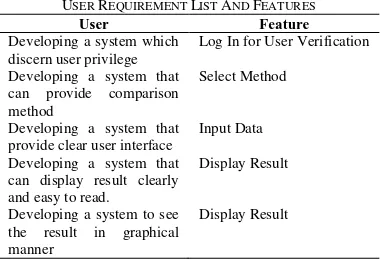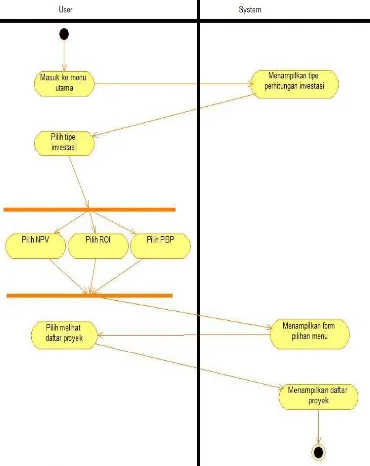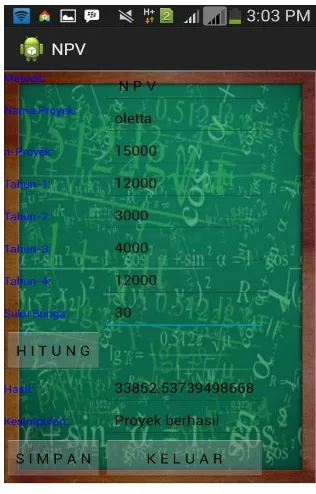16 Stanley Karouw
Program Studi Teknik Informatika, Fakultas Teknik, Universitas Sam Ratulangi Jl. Kampus UNSRAT Bahu, 95115
E-mail : stanley.karouw@unsrat.ac.id
Abstract
North Sulawesi province is fostering regional development towards a society which have values, prosperous and competitive cultures. Information Technology (IT) have become a key enabler to accelerate region developments. To optimize IT utilization, local government can used IT Valuation Matrix framework, to identify all IT Business Value which derived from each IT investing type, and then be quantify in reasonable and responsible manner. IT Valuation Matrix framework also provide best practices to assessing local government IT investment. This article shows the process of designing mobile-android based applications for quantifying IT Business Value based on IT Valuation Matrix method. Using Disciplined Agile Delivery methodology, which based on agility and object-oriented approach, the application that meet user expectations and needs, can be developed.
Keyword : IT Business Value, Application, Agile, DAD, Software Development
Abstrak
Provinsi Sulawesi Utara mendorong pembangunan daerah menuju masyarakat yang memiliki nilai-nilai, makmur dan budaya kompetitif. Teknologi Informasi (TI) telah menjadi kunci untuk mempercepat perkembangan wilayah. Untuk mengoptimalkan pemanfaatan IT, pemerintah daerah dapat digunakan IT Valuation Matrix, untuk mengidentifikasi semua IT Bisnis Nilai yang berasal dari masing-masing jenis investasi IT, dan kemudian mengukur secara wajar dan bertanggung jawab. IT Valuation Matrix juga menyediakan praktik terbaik untuk menilai investasi TI pemerintah daerah. Artikel ini menunjukkan proses merancang aplikasi berbasis mobile android untuk mengukur Nilai IT Bisnis berdasarkan Metode dari masing-masing jenis investasi IT, dan kemudian mengukur secara wajar dan bertanggung jawab. IT Valuation Matrix. Menggunakan Disiplin metodologi Agile yang didasarkan pada agility dan pendekatan berorientasi objek, sehingga aplikasi yang memenuhi harapan pengguna dan kebutuhan, dapat dikembangkan.
Kata kunci: IT Nilai Bisnis, Aplikasi, Agile, DAD, Software Development
1. Introduction
The business realization benefits of IT (or IT busi-ness value) [1][2][3] defined as benefits or results obtained from an IT investment which can im-prove organization performance. IT business va-lue is more than just provide a benefit in finan-cially terms. The IT business value concept inclu-des on how IT proviinclu-des efficiency, effectiveness, increase productivity and create competitive ad-vantage for a particular organization. This IT bu-siness value understanding follows Parker [4][5], where according to Bannister and Remenyi [6] ba-sed on Porter[7] definition about value. This arti-cle will follow IT business value definition pro-posed by Ranti [1][2].
The objective of this article is to demonstrate the analysis and design process of the application for Quantifying IT Business Value based on
Ran-ti’s IT Valuation Matrix Method. This application was developed using agile-approach methodolo-gy, called Disciplined Agile Delivery (or DAD).
2. Methodology
IT Investment Analysis
This method is called IT Valua-tion Matrix. Ranti [1] also takes into account the financial and non financial approach. (See Figure 1). Ranti [1] frame-work begin with classifying the investment type according to the category of mandatory, improve-ment, strategic and infrastructure, where each ca-tegory have different focus, assessment, value, and
quantification process.
Wowor and Karouw [8] using Ranti’s IT Va-luation Matrix method to quantify the identified IT Business Value for Local Government. Using case study approach for North Sulawesi Province, as service-oriented organization, Wowor and Karouw [8] expand Ranti’s IT Valuation Matrix me-thod with IT Business Value Identification and Classi-fication phase, before QuantiClassi-fication stage. Wowor and Karouw [8] also added Clarification Process stage after conduct the Quantification sta-ge for all identified IT Business Value (see Table 1).
Disciplined Agile Delivery (DAD)
Disciplined Agile Delivery [9] developed by Scott Ambler [10]. As stated here [11], DAD is an en-terprise-aware hybrid software process framework.
TABLE 1 learning-oriented hybrid agile approach to IT so-lution delivery. It has a risk-value lifecycle, is goal-driven and is enterprise aware. The DAD process framework is a hybrid: i.e it adopts and tailor stra-tegies from a variety of sources [10]. See Figure 2 for The DAD Process Framework.
3. Results and Analysis
This article show the analysis and design process for build application for quantifying IT business value based on IT Valuation Matrix, proposed by Ranti [1]. Following stages conducted by Wowor and Karouw [8], this application will compute two category of identified IT business value, which are Reducing Cost of (RCO) and Reducing Risk (RRI). For this mobile android version, we have add new features such as Add New Project and Project List. The business process running by this application is shown at Figure 3 and Figure 4, using UML Activity Diagram.
Inception Phase
The main target of inception phase is to understand the scope and objectives of the project and obtain enough information to confirm that we must go on or no. Main result for this phase is User Require-ments. User Requirements have major impact for application development. The artifact which pro-duced user requirements list are called User Sto-ries Card [12]. See Table 2 for User Requirements List, level of priority, feature that must be develop and application functionality.
Other artifact which have minor impact but important also is Software Project Plan document. This document show application estimation in terms of size, the number of developers required, working time and costs required. Using Function Point Analysis technique which explained by Pressman [13], the application estimation process will be compute easily. Table 3 summarized the re-sult.
TABLE 2
USER REQUIREMENT LIST AND FEATURES
User Feature
Developing a system which discern user privilege
Log In for User Verification
Developing a system that can provide comparison method
Select Method
Developing a system that provide clear user interface
Input Data
Developing a system that can display result clearly and easy to read.
Display Result
Developing a system to see the result in graphical manner
TABLE 3
PART OF INCEPTION PHASE ARTIFACTS Software Estimation
Total Adjusted Function Point 152.29
Lines of Code (LOC) 67000
Effort (in person-months) 11.71 Estimate Time Required 7 months
Construction Phase
Construction phase is the next stage in the software development lifecycle according to DAD. The target of this phase is to determine the base archi-tecture of the system and building working appli-cation code follows the base architecture. The ma-jor artifact resulted from this phase activities is Software Architecture Document (SAD). Mostly, SAD document provides the architecture model for
the whole software application system. For this re-search, author using UML 2.0 [14] as tools for ap-plication models as Fowler proposed [15].
We used UML Use Case Diagram and Use Case Descriptions as functional requirements mo-del. However, the complete list of UML Use Case Description are not presented in this paper. Figure 4 depicted UML Use Case Diagram as Functional View Model for this application. This use case model will guide through all construction process. Interface design is the process of defining how the system interacts with an external unit. The user interface consists of three basic parts. The first is the navigation mechanism, a way of giving in-structions to the user and the system tells the Figure 2. Figure 2. DAD Process Framework
system what to do, such as buttons and menus (see Figure 5). The second is the input mechanism, a way of capturing information system (e.g a form to add news). The third is the output mechanism of how the system provides information to users or to other systems (e.g reports, web pages). (see Figure 6).
Transition Phase
The main target of the construction phase is effi-cient and inexpensive development of the end pro-duct, that is, a version of the operational system that can be deployed to the end-user community. The designing and construction of this application is using Android Developer Tools version 22.3.4-8878.26 Android 4.0.
4. Conclusion
This paper show the analysis and design process to develop application for quantigying IT business value which follow IT Valuation Method proposed by Ranti [1]. As Wowor and Karouw [8] conduct, process for quantification and clarification can be done for category Reducing Cost Of (RCO) and Reducing Risk (RRI). Some conclusions from the writing of this paper include: 1) The DAD process framework can be used as guidelines to design mobile-based application for non-profit organiza-tion, such as local government. This process frame-work promote agile-approach and object-oriented paradigm, so can ensure software delivery faster; and 2) The Mobile version Application for Quanti-fying IT Business Value must be develop
compre-hensively for all identified IT Business Value pro-posed by Ranti’s IS/IT Generic Business Value.
References
[1] Ranti, B. (2008). Identification of Informa-tion Systems/InformaInforma-tion Technology Busi-ness Values with Hermeneutic Approach: Ca-ses in Indonesia. Ph.d Thesis. Faculty of Computer Science, University of Indonesia. [2] Ranti, B. (2006). Identifying of Businees
Va-lue of Information Technology using Herme-neutics. Workshop Proceedings, 2006 & 2006 MoMM iiWASS, p. 695-699.
[3] Ranti, B. (2006). A Review of Information Technology Investment Methodologies Eva-lution: The Need for Approriate Evaluation Methods. Paper, National Conference on e-Initiative ICT Indonesia, ITB.
[4] Parker, M. (1988). Information Economics: Linking Business Performance to Information Technology. Prentice Hall, New Jersey. [5] Parker, M. (1996). Strategic Transformation
and Information Technology; Paradigm for Performing while Transforming. Prentice Hall, New Jersey.
[6] Bannister, F. Remenyi, D. (1999). Instinct and Value in IT Decision. Occasional Paper Series. Management Research Centre, Wol-verhampton Business School, the University of Wolverhampton.
Figure 5. Feature Add New Project and List Project
[7] Porter, M. E. (2008). On Competition. Har-vard Business School Publishing Corp., Mas-sachuttes-USA.
[8] Wowor, H., Karouw, S. (2012). Quantifying IT Business Value: Case Study of North Sulawesi Province, Indonesia. Proceedings International Conference on Advanced Com-puter Studies and Information Systems.
[9] DAD Official Website,
http://disciplinedagiledelivery.com/ (accessed at Monday, May 13th 2013)
[10] Scott Ambler Official Website:
http://scottambler.com/ (accesed at Monday,
May 13th 2013)
[11] IBM Software Design and Development, Disciplined Agile Delivery: An Introduction, WhitePaper, 2011, IBM Corporation.
[12] Introduction to User Stories,
www.agilemodeling.com/artifacts/userStory. htm, accessed at June, 7th 2013, 12.00 PM
[13] Pressman, Software Engineering, A Practitio-ner’s Approach, 6th ed, McGrawHill,
Singa-pura, 2005.
[14] Unified Modelling Language: Superstructure Version 2.0, www.uml.org (accesed at Mon-day, May 13th 2013)


